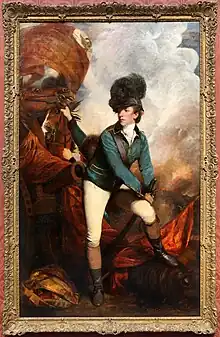
The Tarleton cap, or Tarleton helmet is a type of cavalry helmet that gained popularity in Britain during the late 18th century. It was named after Lt. Col. Sir Banestre Tarleton, a British cavalry officer known for his role in the American Revolutionary War[1] Used by light infantry and light cavalry, it consisted of a metal or leather helmet with antique style applications, a high comb of fur, bearskin or horsehair (woollen for lower ranks) and a fur plume protruding far into the upper front side, with a coloured turban wrapped around the bottom.[2] It was produced between 1793 and 1815.[3]
It is depicted in Sir Joshua Reynolds' portrait of Tarleton,[4] and was named after the officer.
Design
The helmet was based based on the Continental European dragoon helmet that became popular in several other armies before it fell out of fashion.[5] It is characterized by its leather construction, a crest or comb on top, and a large frontal peak. It typically had a chain chinstrap and was adorned with a side plume, often made of horsehair, which could be dyed in various colors to signify different units or ranks. It was known as 'the handsomest of helmets, much admired by foreign nations'.[6][7]
The crest is inspired may have been inspired by the dressed hair of the Mohican.[8]
The helmet was the origin of a fashion for the use of a tassel as decoration on the rear of later 19th-century dragoon helmets.[9]
Usage
Banastre Tarleton, for whom the helmet is named, was a prominent figure in the American Revolutionary War, particularly recognized for his leadership of the British Legion, a loyalist cavalry and infantry force. Tarleton introduced the cap to the British Legion, where it was worn by all ranks.[10]
.jpg.webp)
Some British light infantry adopted the helmet during the American War of Independence using it unofficially from around 1780.[11] The cap was adopted by light infantry of both sides during the conflict and was also used by dismounted cavalry serving as infantry.[12] It was adopted by British light dragoons in 1784 and worn through the early Napoleonic wars.[13][14] The light dragoons replaced the caps with the mirliton after 1796.[15]
The helmet was used by the Royal Horse Artillery until the end of the Napoleonic Wars, light infantry[16] and light cavalry regiments[17][18][19] Its use was advocated at the time as being less fatiguing to wear while offering good protection. It was prone to warping.[20] It has been noted as being top heavy in difficult to wear at a pace faster than a walk.[21]
The helmet was worn by the Prince Regent in Sir William Beechey's 1798 painting of 'George III at a Review'.[22]
References
- ↑ "England - Tarleton cap". www.rct.uk. Retrieved 20 September 2023.
- ↑ Forrest, A.; Hagemann, K.; Rendall, J. (27 November 2008). Soldiers, Citizens and Civilians: Experiences and Perceptions of the Revolutionary and Napoleonic Wars, 1790-1820. Springer. ISBN 978-0-230-58329-0. Retrieved 11 December 2023.
- ↑ "Tarleton Helmet | York Museums Trust". www.yorkmuseumstrust.org.uk. Retrieved 20 September 2023.
- ↑ "Helmet made famous by the dashing but dastardly Banastre | Antiques Trade Gazette". www.antiquestradegazette.com.
- ↑ "Top 10 Banastre Tarleton Myths – Journal of the American Revolution". 20 September 2023.
- ↑ "Tarleton pattern helmet, Wiltshire Yeomanry Cavalry, 1800 (c) | Online Collection | National Army Museum, London". collection.nam.ac.uk. Retrieved 20 September 2023.
- ↑ "Officer's Tarleton pattern helmet, Light Dragoons, 1806 (c) | Online Collection | National Army Museum, London". collection.nam.ac.uk. Retrieved 20 September 2023.
- ↑ Kavanagh, Gaynor (1 December 2005). Making Histories in Museums. Bloomsbury Publishing. p. 156. ISBN 978-0-8264-3072-4. Retrieved 11 December 2023.
- ↑ Haythornthwaite, P. J. (1980). "1771. AN OFFICER OF THE BOMBAY HORSE ARTILLERY, c 1850". Journal of the Society for Army Historical Research. 58 (235): 175–176. JSTOR 44230334. Retrieved 9 January 2023.
- ↑ "Helmet made famous by the dashing but dastardly Banastre | Antiques Trade Gazette". www.antiquestradegazette.com. Retrieved 11 December 2023.
- ↑ Matthews, A. S. (1964). "THE UNIFORM OF THE 15th (OR KING'S) LIGHT DRAGOONS, 1789". Journal of the Society for Army Historical Research. 42 (172): 175–178. JSTOR 44235028. Retrieved 5 January 2023.
- ↑ Franklin, Carl (1 January 2012). British Army Uniforms of the American Revolution 1751-1783. Casemate Publishers. ISBN 978-1-84884-690-6. Retrieved 11 December 2023.
- ↑ Haythornthwaite, Philip (20 April 2012). British Cavalryman 1792–1815. Bloomsbury Publishing. p. 31. ISBN 978-1-78096-682-3. Retrieved 11 December 2023.
- ↑ Esposito, Gabriele (8 December 2021). Wellington's Cavalry and Technical Corps, 1800–1815. Pen and Sword Military. ISBN 978-1-3990-0548-7. Retrieved 11 December 2023.
- ↑ Mollo, John (14 November 2013). From Corunna to Waterloo: With the Hussars 1808 to 1815. Pen and Sword. ISBN 978-1-4738-3152-0. Retrieved 11 December 2023.
- ↑ Esposito, Gabriele (19 March 2021). Wellington's Infantry: British Foot Regiments, 1800–1815. Pen and Sword Military. ISBN 978-1-5267-8668-5. Retrieved 11 December 2023.
- ↑ "British Artillery : Napoleonic Wars : Horse : Foot : Rockets : Uniforms". Archived from the original on 2023-01-05.
- ↑ Liliane and Fred Funcken: L'uniforme et les armes des soldats de la guerre en dentelle, Casterman, Tome 1, 1975 ISBN 2203143150 et tome 2, 1976 ISBN 2203143169. In particular: book 1 p. 128 for light infantry and book 2 p. 52-61 for light cavalry.
- ↑ Liliane et Fred Funcken: L'Uniforme et les armes des soldats du Premier Empire, Casterman, tome 1, 1968, p. 116-117: « l'artillerie britannique »
- ↑ Haythornthwaite, Philip (20 December 2013). Napoleonic Light Cavalry Tactics. Bloomsbury Publishing. ISBN 978-1-78096-104-0. Retrieved 11 December 2023.
- ↑ Kiley, Kevin F. (15 March 2021). Artillery of the Napoleonic Wars: A Concise Dictionary, 1792–1815. Frontline Books. ISBN 978-1-84832-955-3.
- ↑ https://www.rct.uk/collection/67185/tarleton-cap.
{{cite web}}: Missing or empty|title=(help)